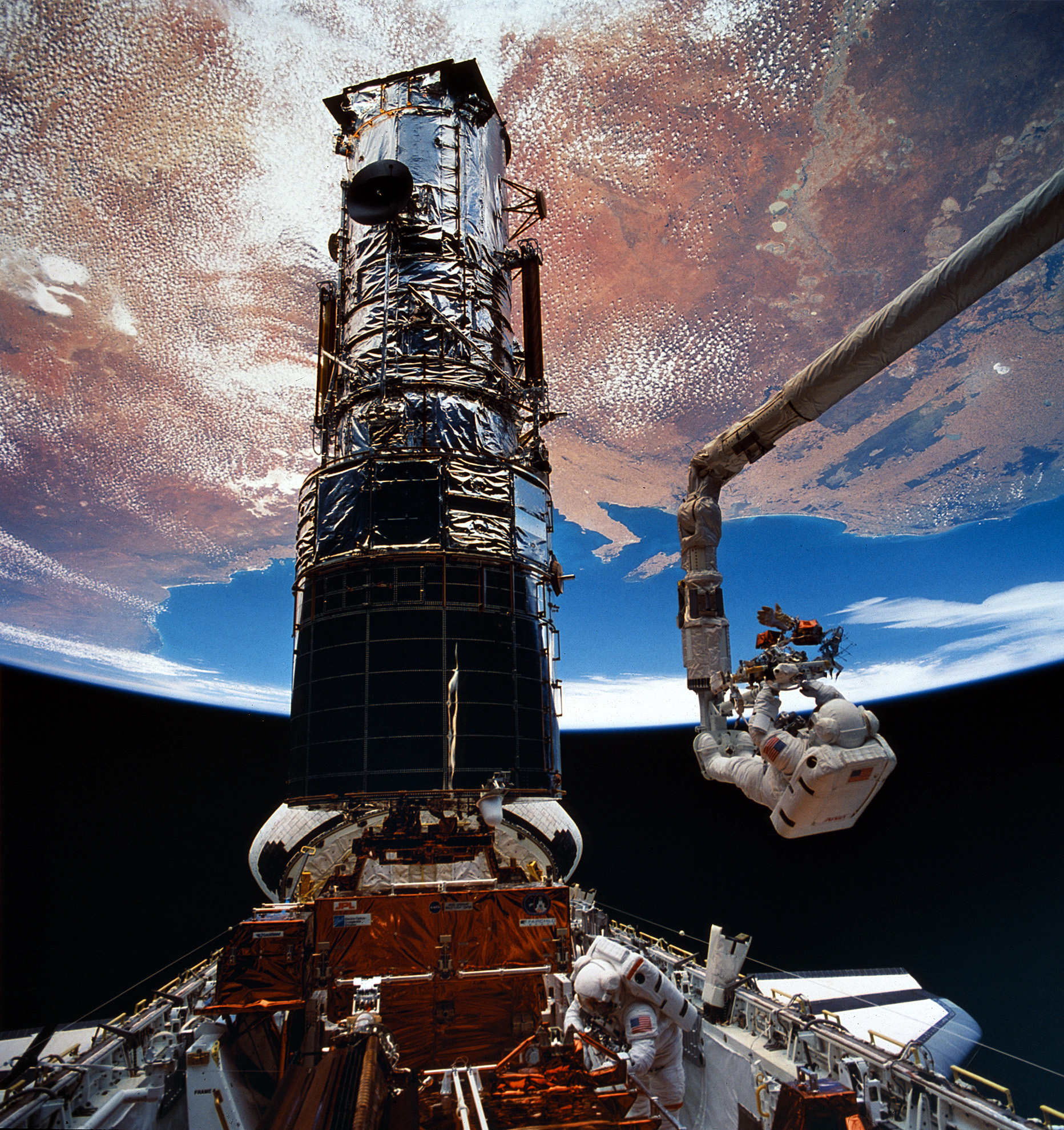
More than two decades have passed since one of the most spectacular EVA missions in U.S. history: the long-awaited first servicing of the Hubble Space Telescope (HST). Launched in April 1990, the $1.5 billion observatory was the jewel in NASA’s scientific crown, but shortly afterwards fell foul to the effects of a spherical aberration in its primary optics, which severely impaired the quality of its images. With funding for Space Station Freedom—later to evolve into the International Space Station (ISS)—hanging on the edge of a knife, a successful repair and rejuvenation of Hubble was critical not only to the telescope’s future, but to the future of NASA itself. In December 1993, the seven-member crew of Endeavour launched on STS-61, an 11-day flight to perform a record-setting series of five EVAs to bring Hubble back from the brink of disaster and restore the space agency’s tattered reputation. In doing so, they accomplished one of the most spectacular human space missions of the decade and demonstrated the shuttle’s capabilities for the future.
Central to the repair effort was the $50 million Corrective Optics Space Telescope Axial Replacement (COSTAR), fabricated by Ball Aerospace, which would correct the spherical aberration by positioning 10 small, coin-sized mirrors to restore the potential of Hubble’s affected scientific instruments. However, in order to make room for COSTAR, another instrument—the phone-booth-sized High Speed Photometer (HSP), rendered useless by “jittering” in the telescope’s solar arrays—would need to be removed and returned to Earth. “Once in place,” explained NASA’s STS-61 Press Kit, “COSTAR will deploy a set of mechanical arms, no longer than a human hand, that will place corrective mirrors in front of the openings that admit light” into the affected instruments. In doing so, it would refocus light from Hubble’s primary mirror before it reached those instruments and was expected to bring their overall optical performance “very close” to original specifications. Follow-on instruments for the telescope would be specifically designed with their own corrective optics already pre-integrated.
Additional tasks included the installation of a new Wide Field Planetary Camera (WFPC-2), the replacement of Hubble’s twin solar arrays and drive electronics, two of three Rate Sensing Units (RSUs), one of two Electronic Control Units (ECUs), one of two magnetometers, and fuse plugs to correct wiring discrepancies. In March 1992, Story Musgrave was assigned as payload commander for the flight, and in August fellow astronauts Jeff Hoffman, Kathy Thornton, and Tom Akers joined him to support at least five ambitious EVAs. The final members of the crew—Commander Dick Covey, Pilot Ken Bowersox, and European Space Agency (ESA) astronaut Claude Nicollier—were named in December 1992, tracking a December 1993 launch. With the repair work, STS-61 had morphed into a far more complex mission than had been anticipated before Hubble’s launch.
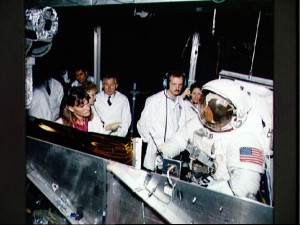
In its January 1990 manifest, the agency listed SM-1 as a five-day flight with a crew of five, suggesting a maximum of only two or three EVAs, but as 1991 wore into 1992 and onward into 1993 it became increasingly clear that the mission would run to as long as 11 days and evaluations of underwater simulations convinced managers that they should schedule as many as five back-to-back EVAs over five days. According to Mission Director Randy Brinkley, the decision served to “repackage our margin” and offered the chance to “respond to the dynamics, or unknowns, of spacewalks.” (The flight plan actually provided for a sixth and seventh EVA, and a mission duration of up to 13 days, although this was did not become necessary.)
Such an enormous workload demanded a crew of seven, with two alternating teams of spacewalkers, to reduce fatigue and enhance the likelihood of mission success. Original plans called for all tools to be kept outside, in the shuttle’s payload bay, but the crew recognized at an early stage that EVA time was a critical limiting consumable and decided that the hour spent preparing equipment at the start of each excursion could be better spent starting the repair work. It was therefore decided that some tools would be kept inside Endeavour’s crew cabin, enabling the spacewalkers to “load-up” before opening the airlock and utilizing their suits’ consumables. “What we’ve done by going to five EVAs, rather than three, is to repackage our margin,” said Brinkley, “so that we have the capability to respond to the dynamics, or unknowns, of spacewalks. It improves the probabilities for mission success, while providing added flexibility and adaptability for reacting to real-time situations.”
“Doing five [EVAs] really pushed the bounds of what people thought we could do,” Covey recalled in his NASA oral history. “Even with four EVA crew members, even with an 11-day mission, it just started pushing the bounds. There was a lot of scrutiny on it and a lot of focus on it.” The size of their quarry posed additional problems. Hubble was far larger than anything with which the shuttle had previously rendezvoused in orbit, and Claude Nicollier was faced with the unenviable challenge of maneuvering his EVA crewmates, along with phone-booth-sized pieces of hardware, into position by means of the Remote Manipulator System (RMS) mechanical arm with extreme delicacy and precision. “The integrated operations,” said Covey, “of shuttle maneuvering, RMS activities and EVAs, although now commonplace, wasn’t back then. So integrating all of those activities and the crew activities together was a big part of my role as the commander.”
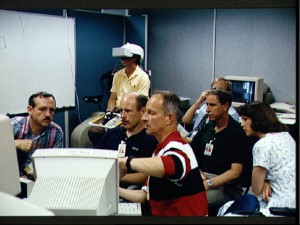
All of the spacewalkers recognized the need to develop physical strength to handle the demands of their space suits and build the necessary stamina for six or seven hours outside. Kathy Thornton worked out in the gym, as did the others, although by Hoffman’s admission most of the servicing tasks did not demand immense physical strength, but placed greater emphasis on “technical co-ordination,” involving them “being very careful in how you moved things around and not messing anything up.”
Following a successful launch on 2 December 1993, it was recognized that the spacewalks would be performed daily, with Musgrave and Hoffman charged with the first, third, and fifth and Thornton and Akers assigned to the second and fourth. Encased within their pressurized suits, the astronauts were identified by the presence (or absence) of markings on their legs: Hoffman (EV1) would have red stripes, Musgrave (EV2) would have no stripes, Thornton (EV3) would have dashed red stripes, and Akers (EV4) would have diagonal broken red stripes. All four spacewalkers were extensively “cross-trained” to allow them to perform any one of the mission’s given EVA tasks and around 200 tools, from power ratchets and sockets to safety bars and articulating foot restraints and from portable work lights and locking connectors to instrument covers, handles, and umbilical connectors.
Looking back on those adrenaline-charged days, Covey was filled with pride that his crew accomplished everything they set out to do. “There wasn’t anybody that was chilling down on the middeck,” he said. “Everybody was up top, working. There was concern about whether we could sustain that tempo. We went five straight days doing EVAs and that was the right answer. Everybody felt good about that. Nobody was getting excessively fatigued. The EVA crew members, because they were getting a day off in between were okay with that and so that facilitated us pressing on with five straight days of spacewalks.”
All five EVAs were significant in reviving Hubble, but in the eyes of the public and politicians perhaps the most critical tasks were the installation of WFPC-2 by Musgrave and Hoffman on EVA-3 on 6/7 December 1993 and the installation of COSTAR by Thornton and Akers on 7/8 December. Before launch, Hoffman remembered being told not to worry if they did not accomplish everything on the manifest; as long as either WFPC-2 or COSTAR was successfully installed, the scientists on the ground would be “deliriously happy.” However, they were not fully appreciative of NASA’s collective mindset of having a 100-percent-successful mission.
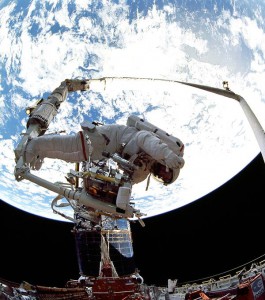
WFPC-2 had originally been developed in 1985 as a “spare,” but after the discovery of the spherical aberration NASA had requested the installation of an optical corrector. “The new design incorporates an optical correction by the refiguring of relay mirrors already in the optical train of the cameras,” read NASA’s pre-flight press kit. “Each relay mirror is polished to a new specification that will compensate for the incorrect figure on [Hubble’s] primary mirror. Small actuators will fine-tune the positioning of these mirrors on-orbit, ensuring the very precise alignment that is required.” The WFPC team also upgraded the instrument, by reducing the number of cameras from eight to four in order to develop an alignment system and adding improved charge-coupled devices to aid its ultraviolet sensitivity.
An hour into the spacewalk, Hoffman crisply removed the original WFPC-1 from its housing in Hubble’s bowels and inserted it into a storage container in the payload bay. A protective hood was then removed from the new device and it was installed perfectly. Ground controllers ran an “aliveness” test and verified that the pie-wedge-shaped WFPC-2 was working correctly. The spacewalkers then replaced a pair of magnetometers, before returning inside Endeavour after six hours and 47 minutes. This proved exceptionally good time, when one considers that training for the WFPC-2 replacement alone had typically taken 4.5 hours in the water tank.
A day later, Thornton and Akers set about exchanging the HSP for COSTAR. This required them to open the telescope’s bay doors and loosening latches and removing electrical connectors in order to slide out the instrument. The new corrective optics package was then fitted. In training on Earth, the operation had taken around 3.5 hours. The intensity of the mission—an intensity which had impacted Story Musgrave for almost two years, to such an extent that he remarked, with the merest hint of jest, that the only peace and solace he could find from the mission was sitting in the dentist’s chair—began to lessen somewhat when Thornton and Akers successfully removed the photometer and installed COSTAR in its place. By the end of the EVA, both WFPC-2 the corrective optics had been triumphantly fitted.
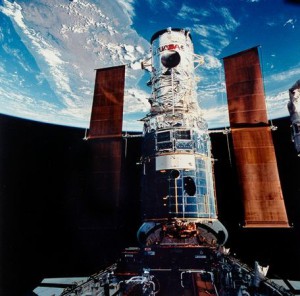
Although these two EVAs restored much of Hubble’s science-gathering capability, the other three excursions of STS-61 replaced its solar arrays and other critical equipment and transformed the telescope into virtually a new spacecraft. From an EVA perspective, the records fell like ninepins during STS-61. By the time EVA-5 was completed, the four spacewalkers—Musgrave, Hoffman, Thornton, and Akers—had totaled more than 35 hours outside Endeavour and five excursions on a single flight was more than had ever been achieved on a single shuttle mission. Moreover, STS-61 was the first shuttle flight in which the bounds of accomplishment, in terms of mission duration, complexity, and integrated EVA-RMS-orbiter operations, were pushed to their absolute limits.
That night, the night after the final EVA, the crew of STS-61 celebrated their success above the roof of the world. “Of all of the programs that I have been associated with,” Dick Covey remembered, years later, “it’s the one that was best planned and has been best executed, in terms of using astronauts and crewed vehicles to be able to support, enable and enhance the scientific mission of space.” STS-61 had done nothing less than save NASA itself. Few other human space missions since Apollo 11 had exerted such a positive influence on the agency’s subsequent fortunes. Of course, we know today that fixing Hubble’s optics was triumphantly successful, and the telescope repair team received the prestigious Robert J. Collier Trophy in May 1994 for their work. The citation praised their “outstanding leadership, intrepidity and the renewal of public faith in America’s space program by the successful orbital recovery and repair of the Hubble Space Telescope.”
This is part of a series of articles to commemorate 50 years of U.S. Extravehicular Activity. Tomorrow’s article will focus on three historic EVAs by Dave Scott, Al Worden, and Jim Irwin during Apollo 15 in July-August 1971: the first Stand-Up EVA on the lunar surface, the discovery of the “Genesis Rock,” and the first Deep-Space EVA.
Want to keep up-to-date with all things space? Be sure to “Like” AmericaSpace on Facebook and follow us on Twitter: @AmericaSpace
Missions » US EVAs »



One Comment
One Ping
Pingback:‘This True American Icon’: Remembering Atlantis on 30th Anniversary of Maiden Flight (Part 5) « AmericaSpace